As the title suggests, ‘Billboard’ magazine began life as a trade paper for the bill posting industry at a time when slapping posters on blank walls was viewed as a helpful and constructive pursuit, not an act of anti social vandalism. It was started in 1894 by two American visionaries called William Donaldson and James Hennegan as a ‘paper of record’ for circuses, carnivals, amusement parks, fairs, minstrel shows, whale displays and whatever else appealed to the public taste of the day, and evolved into a publication that covered motion pictures in 1909, radio in 1920 and music charts by the early 1930s. By 1961 Billboard Music Week concentrated solely on the music business, publishing three weekly sales charts – Pop, Country & Western and Rhythm & Blues. Along with Cashbox magazine, it became one of the leading trade publications for the music industry, providing news, domestically and internationally, advertisements, updates, technical developments and many other issues pertinent to industry professionals. The recent posting of almost every issue dating back to the 1940s and extending to modern times, provides a fascinating insight into various periods of music history. Every issue published between January 1963 and December 1973 was carefully perused in an attempt to capture the mood, spirit and psychology of the most important decade in the introduction and development of rhythm & blues and soul music in America, and around the world.
In the earlier 1960s magazines the placement, prominence and priority of R&B adverts tended to reflect the social standing, budgetary restraints and artistic perceptions of the music. The Pop charts assumed the greatest visibility and positioning, followed by C&W and then R&B. Most full-page ads featured white artists, usually accompanied by a photograph, in both Pop and C&W contexts, while most ‘black’ ads, including many of the early Motown singles, did not identify the singers pictorially. This is in stark contrast to C&W artists who, on almost every occasion, have an accompanying photograph within the ad. This did change however, as the decade proceeded, quite probably due to the popularity, and economic success, of black music in the greater commercial arena. Inevitably, the most successful companies tended to advertise the most and with the greatest prominence. Companies like Atlantic, Motown, RCA regularly placed full page ads, (although Motown retained a reticence to publish photographs, choosing, instead, to use drawn art depictions) and smaller companies like Jewell/Paula, Okeh, Date, Loma and many others advertised on a regular basis, including photographs of their artists.
Of particular interest to soul fans are the ads for records that did not achieve commercial success, and that would subsequently become collectors’ items with inflated price tags. Full page ads were taken out for white artists like Paul Anka , Frankie Valli, Dana Valery, The Tempests, Nancy Ames, Lada Edmund Jnr., who, it transpired was the ‘Girl in the cage’ from hit television show ‘Hullabaloo’, Dusty Springfield, Evie Sands, Susan Rewis and David and the Giants, most with photos. In stark contrast, obscure black artists that merited full page status, were rarely visually identified. Yet, full colour ads were placed for the Jelly Beans, the Younghearts, Nikki Blu and the Bronzettes, Donald Height, Gladys Knight and the Pips, Edwin Starr, to name but a few, with black and whites published for people like Dobie Gray, Candy and the Kisses, Barbara Acklin, Jackie Wilson, Homer Banks, Willie Mitchell, Steve Karmen Big Band (!) and Emanuel Laskey . The hope, confidence and expectation record executives must have shown, as promotion expenses were decided and cheques made out to ‘Billboard’ were written!
When asked about the failure of their record(s) to become a hit, many artists will cite a lack of promotion by the record company. While this may be true in many cases, the pages of Billboard clearly show that many small, independent record labels attempted to compete with their much larger counterparts in the chase for that elusive success. Promotional campaigns ranged from the insertion of one small ad., in a single issue; to a regular spot espousing several different releases, or a full page with photographs and details of radio play. It is fascinating to discover which obscure artists and/or labels appeared, especially when, with the benefit of hindsight, the eventual failure is considered. Ironic too, that many of them have soared in value as collectors realised their true worthiness and worth. Artists like the Hytones, the Volcanoes, Sam Fletcher, Bobbie Smith, the Aubrey Twins, Bobby Paris, Rhetta Hughes, Barbara Mills, the Volumes, Tommy Navarro, Jimmy Robbins, Cindy Scott, Bunny Sigler, George Smith, Kenny Gamble, plus others, are advertised while labels like 123, Musicor, Excello, Blue Rock, Zea, Soul City, Arctic, Huff Puff, Joda, Dynamo, Scepter, SSS International, Jamie-Guyden, Sidra, Quinvy, Jubilee and many more are featured. Of even more interest are the adverts that contain photographs of artists, many of whom have been previously unidentified or anonymous. Roy Redmond, J. B. Troy, Don Ray Sampson, Porgy & Monarchs, the Justifiers, Bobby Patterson & Mustangs, Jimmy Robbins, Sisters Love, Tony & Tyrone, Spellbinders, Roger Hatcher, Maskman & Agents, Preston Foster, Ruth McFadden, Barbara & Brenda, Sam & Bill, Timothy Carr, Toni & Hearts, Debbie Rollins and Chuck Edwards are just a few of the artists identified.
Perhaps the most amazing advert on show was commissioned by Golden World / Ric Tic and published on 23rd October 1965. Under the banner ‘Hits A’ Go-Go’ are five new Ric Tic/Volkano/Wingate releases including Wingate 009, Jimmy Randazzo ‘Hungry for love’ which was never ever released! One can only surmise that it was a vocal to the San Remo Strings release but, as it has never surfaced in any form, this is open to speculation.
Almost as interesting as the advertising are the reviews of records and the related news items. The language used in both areas displays a dated naivety and innocence that captures the spirit of the age. Words like ‘wail’, ‘driving’, ‘powerhouse’ ‘rocker’, ‘beat’, and many other equally quaint phrases and terms, appear frequently. A Billboard critique of the Younghearts ‘A little togetherness’, for instance, describes it as “Powerhouse teen dance beat and good group sound”, Major Lance’s ‘Investigate’ is “An exciting vocal performance on this wailing rocker.” ‘Help me’ by the Spellbinders “Hard driving beat backs an exceptional vocal performance”, Barbara Banks’ ‘River of tears’ receives “This rocker should be a sales monster. Wild wailing vocal work with strong support from the driving Herb Bernstein arrangement” and Kurt Harris’ “Emperor of my baby’s heart” is portrayed as “An impressive ballad and the artist has a good new sound used to great effect on this budding side” Jackie Ross’ Chicago recording ‘I’ve got the skill’ is called “A high pitched ‘chi chi’ vocal coupled with a Detroit beat” whatever a ‘chi chi’ vocal is! Marie Knight’s ‘That’s no way to treat a girl’ is a “Powerhouse wailing performance on pop hit material. Strong dance beat. The Devonaires (sic) ‘Please don’t say we’re through’ merits “Zippy beat and catchy arrangement. Gals are in the groove.” The best, and most creative, narrative however belongs to this gem from October 17th 1964 in a review describing Earl Van Dyke’s ‘Soul stomp’. “Socko instrumental spotlighting swinging organ with pow pow beat supplied by big brass. Really moves out.” Most reviews were only two or three lines long and followed a similar pattern. The ‘wrong’ sides were sometimes reviewed, as was the case with Nancy Ames’ ‘Cry softly’ instead of ‘I don’t want to talk about it’, Little Richard ‘Hurry sundown’ instead of ‘I don’t want to discuss it’ and Ben E King ‘Goodnight my love’ instead of ‘I can’t break the news to myself’ to name but a few, notwithstanding the preponderance of many rare soul favourites actually beginning life as ‘B’ sides.
By 1967 a regular weekly R&B news update column, called ‘Soul Sauce’, began featuring snippets of news, tour details, future releases, ‘live’ appearances plus much more under the sub heading ‘Soul slices’. It was written by a white journalist, Ed Ochs, who also launched a weekly element called ‘Best new record of the week’. His judgement appears to have predated future rare soul tastes, if his choices are anything to go by! Accompanied by photographs, the following artists received this accolade – the Constellations, Big Ella, the Vibrations, Billy Guy, the Esquires, the Invitations, Maxine Brown, Diane Lewis, the Hesitations and Ruby Winters with songs that, in every case, failed to achieve significant chart success. His use of the term ‘soul’, while in common usage throughout wider society at the time, wasn’t adopted by Billboard, officially, until August 1969 when it announced that “ The change in terminology will be reflected in chart headings as well as regular editorial text.” adding “ …this change is motivated by the fact that the term ‘soul’ more properly embraces the broad range of song and instrumental material which derives from the musical genius of the black American.” as if ‘the black American’ was some kind of separate species. Or perhaps that was the intent? Amazing that it took the editorial staff over two years to make the change. Draw your own conclusions.
Although the number of the more significant stories and reports relating to R&B/Soul matters were sparing, at best, those that made it through make interesting reading. In the October 28th, 1967 edition under the bi-line ‘STAX REDESIGNS LOGO TO FOIL COUNTERFEITERS’ Jim Stewart complained that Stax material had been “…run off by the thousands” and that the company would be ‘…shortly coming out with a complex multi-colored (sic) label that will be more difficult to counterfeit.’ He complained, “ …penalties for bootleggers are not stiff enough. We can’t seem to convince anyone that this is a major crime.” How many collectors will be checking their light blue U.S. Stax issues now? The legendary Loma label was mentioned on October 3rd, 1964 when the first release, ‘Baby don’t look down’ by Billy Storm ‘ has passed 6000 in sales. An executive revealed that the label is on a major recruitment drive and will have the top two artists in the R&B field on the label by the end of the year.’ Another label that received an initial mention was Turntable Records on August 14th 1965. ‘Turntable’s first product is George Smith, the current lead singer of the ‘new’ Ink Spots, singing ‘I’ve had it’. Major shareholder is Sam Goody owner of a national chain of record stores.’ An accompanying review announced ‘Dramatic, soulful performance serves as an exciting debut of artist and label.’ In the same issue, in bold type, the following bi-line appeared - ‘JOHNNY BRAGG DENIED PAROLE’ and a detailed account of the circumstances surrounding his previous convictions, the reasons for the denial and the disclosure that he ‘…is not ready for civilian life again.’ Seems excessive, considering that the only reason given for such a detailed and lurid story was the fact that he had written the 1956 hit ‘Just walkin’ in the rain’ while in prison. Wonder if a white songwriter would have received the same coverage. Of previously unknown provenance was a story involving Shelley Haims, the executive who brokered the deal to connect Pied Piper productions in Detroit with RCA in 1967. In the July 24th 1965 edition of Billboard it was announced that ‘Shelley Haims named as Vice President and General Manager of Golden World, Ric Tic and Wingate Records in charge of marketing, promotion and product control. He will report to Joanne Bratton (President)’ Remarkable how his name has never been mentioned in any previous histories of the label, the studio or other business dealings. There are some interesting photographs within the pages though they are usually extremely small. Shots of Scott Reagan with Martha & Vandellas, Susan Rewis with Ronnie Savoy, Eddie Anderson with the Four Tops, Aretha being signed by Atlantic vice president Jerry Wexler are probably the best.
The musical rivalry between Motown and Stax during the 1960s and 1970s highlighted the vastly different styles of delivery and expression each company portrayed. The approach to advertising their products varied greatly too. Motown tended to place more emphasis on artistic display type ads, with few photographs of artists, whereas Stax, under the Atlantic banner, stuck to a similar, relatively simple lay outs with photographs included. Atlantic’s promotional material tended to stick to the same formula throughout the sixties and early seventies, whereas Motown’s changed quite dramatically as the decade progressed. Early Motown ads tended to feature several releases at a time, usually encased in a separate and unique theme design. As the company grew in stature and wealth, more sophistication was employed on their publicity campaigns. The innovation and creativity of Motown’s promotion reached it’s peak in the late 1960s when classical references were used in the images that accompanied songs like ‘I love you madly’ ‘I want my baby back’, ‘Ain’t no mountain high enough’ ‘Love child’ and many more.
Both companies used the pages of Billboard to promote or announce matters not directly associated with record promotion. In early 1965 Motown published a double page colour ad promoting the upcoming tour of Britain and France (one show in Paris) with photographs of the artists and the full itinerary. Interesting to note that Goergie Fame opened the shows. Following the tragic deaths of Otis Redding and most members of the Bar Kays in a plane crash in 1967, Atlantic commissioned full page ads commemorating their passing. Not long after this Calla Records produced a similar tribute on the death of Martin Luther King and later still London Records posted a salute to the passing of Hi Records founder Joe Coughi. Motown’s publishing arm, Jobete was featured on several occasions, as was a tribute to Berry Gordy Jr. by his staff on the announcement of his winning a prestigious business award , and a bizarre exchange between Gordy and Bill Cosby appeared discussing the release of his interpretation of Stevie Wonder’s ‘Uptight’, ‘Little old man’. In 1968 an appeal to help boxer Joe Louis was published listing Berry Gordy Jr.as Honorary Chairman of the ‘Salute to the Champ Joe Louis’ appeal.
By the early 1970s full page ads began to appear detailing the availability of recording facilities, list of artists operating out of a particular city or on a group of labels, and the launch of ‘new’ labels. Enterprise Records and Music Merchant Records were announced this way. For the first time in print, Motown produced ads for The Undisputed Truth that gave equal billing to the songwriters/producers, Norman Whitfield and Barrett Strong, and featured photographs of the entire ensemble. Generally, the artistic quality and creativity of ads during this period declined markedly. Stax provided two full colour pages of their artist roster and studio facilities and Sam Phillips published a tribute to the soulful music being produced in Memphis
Rob Moss
-
 1
1


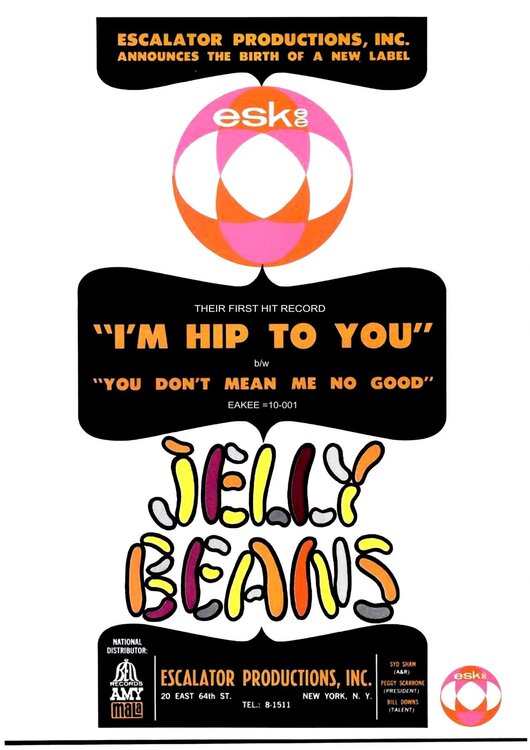
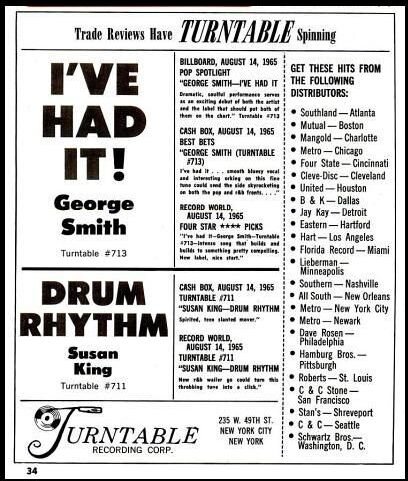
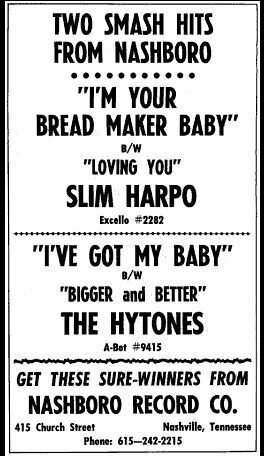
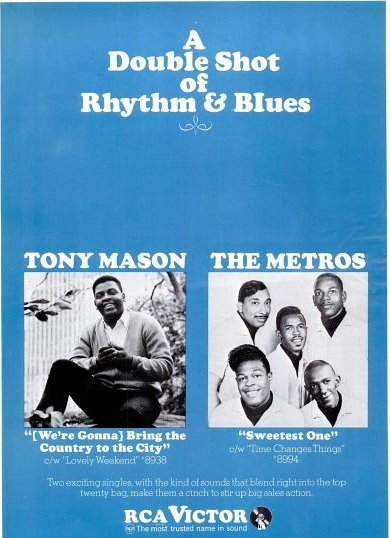
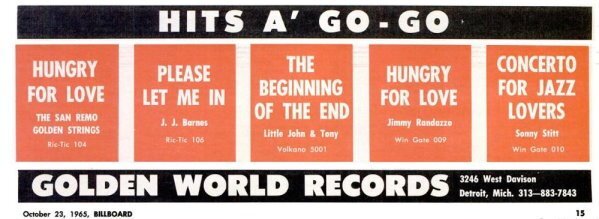
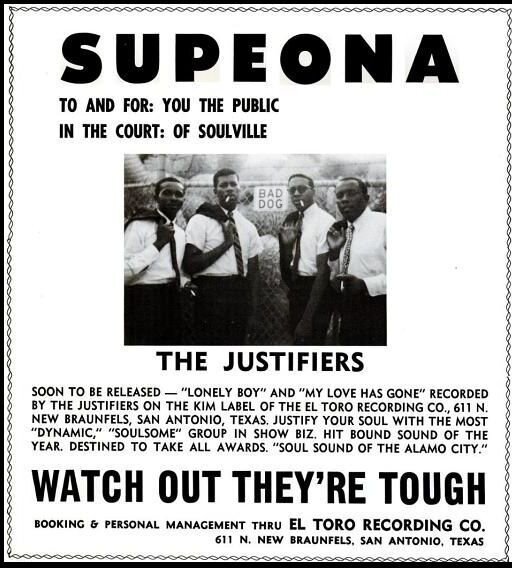
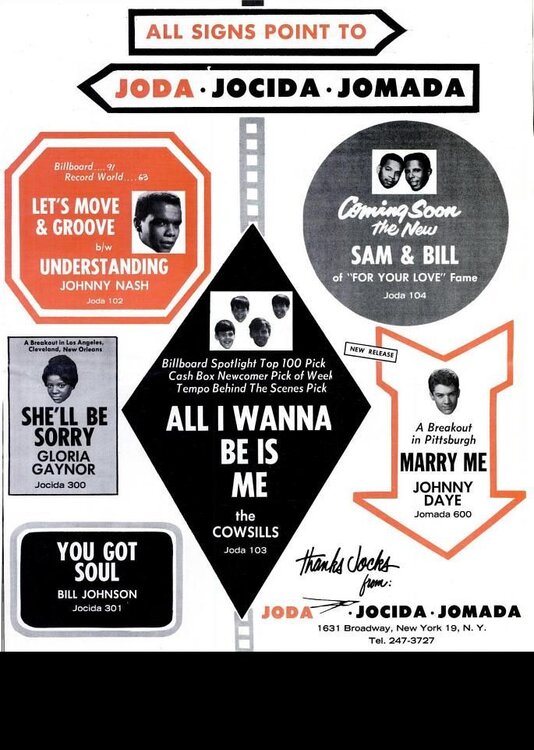
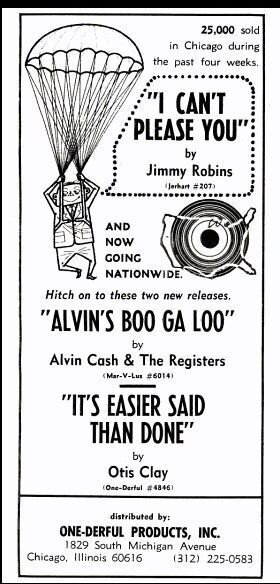
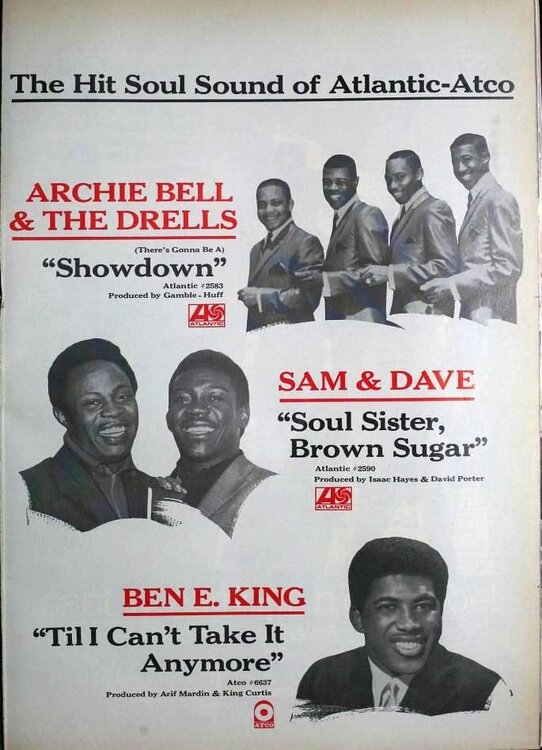
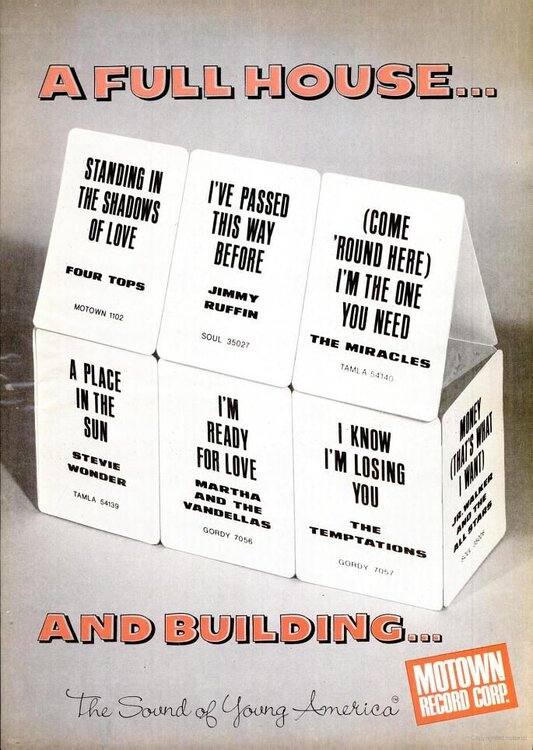
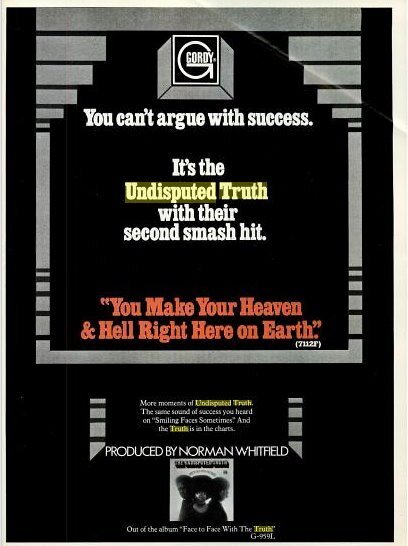
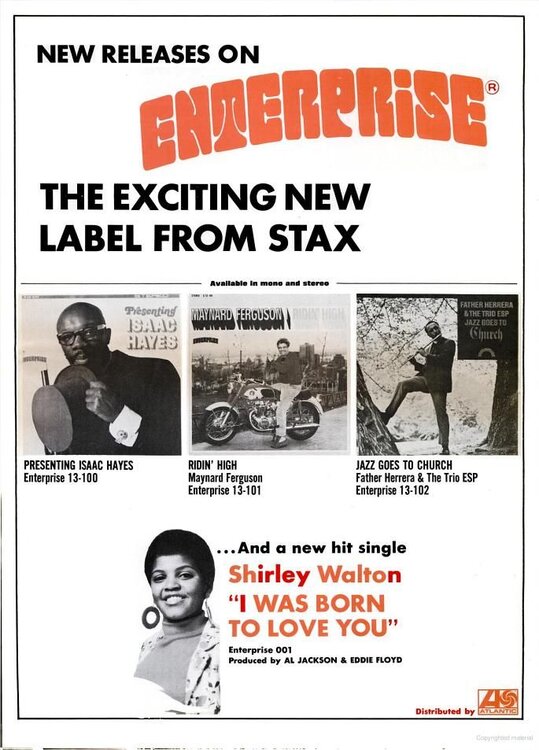

Recommended Comments
Get involved with Soul Source
Add your comments now
Join Soul Source
A free & easy soul music affair!
Join Soul Source now!Log in to Soul Source
Jump right back in!
Log in now!